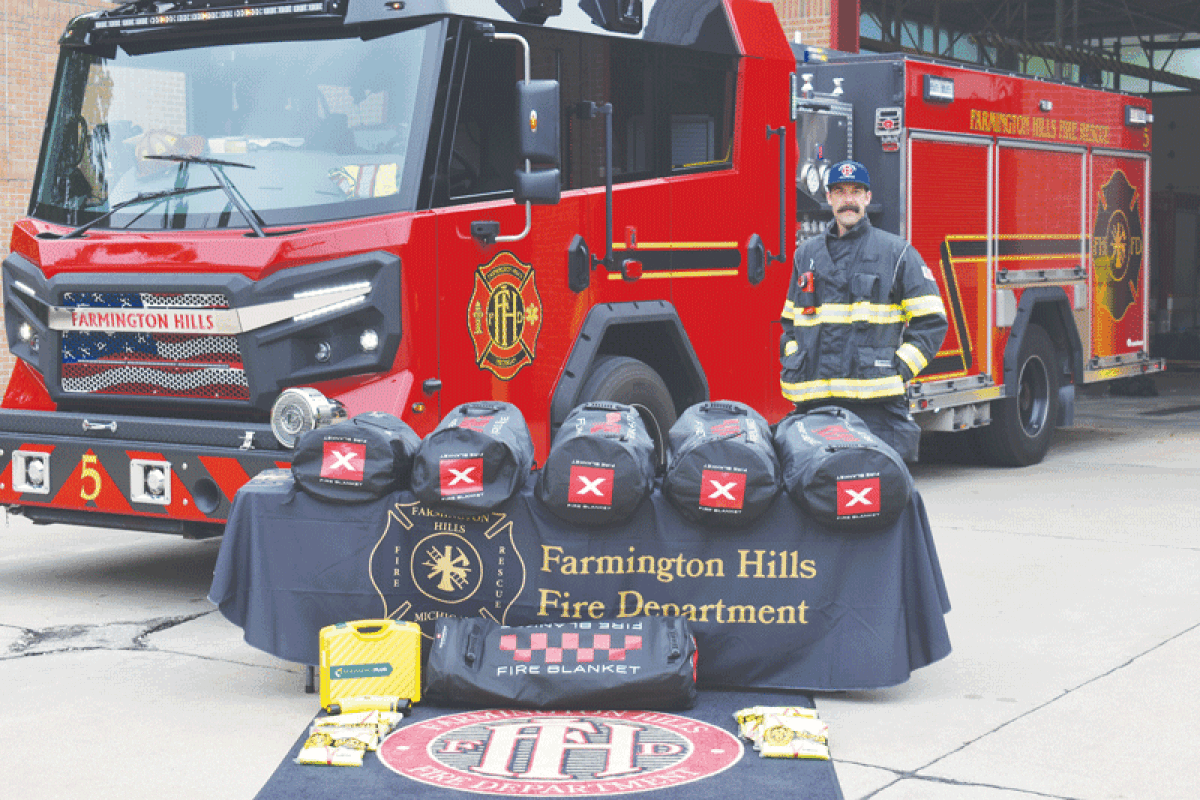FARMINGTON HILLS — With electric vehicles having become more popular on the roadways, the Farmington Hills Fire Department has taken a step toward keeping residents, as well as vehicles, safer.
According to a press release from the city of Farmington Hills, due to a new grant funded by the Auto Club Group Foundation, the Fire Department is now equipped to address hazards associated with electric vehicles, including fires and accidents.
New roadway safety equipment for the department includes six electric vehicle fire blankets, traffic safety vests and an electric vehicle plug to shut off an EV involved in an accident.
The equipment was supplied to the department by AAA at no cost to the city or its residents, with a “value savings” of $10,500, according to the release.
Fire Chief Jon Unruh credited Jason Baloga, who is the department’s fire marshal, with having a “great idea” and authoring the grant.
“With the popularity of electric vehicles in the future, the department’s foresight to making sure that we are prepared to respond to these incidents (is) very important,” Unruh said. “Fortunately, through this grant, we are able to acquire some very important tools that’ll not only address electric vehicle fires, but electric vehicle accidents as well.”
According to Baloga, all of the firefighters in the department are fully trained on how to utilize the new equipment.
“Call it a tool in the toolbox just in case they may need to utilize it on a scene to make things safer,” Baloga said. “Modern gas-powered vehicles are still prevalent on the roadway, but we’re already starting to see (an) increase in EV vehicles on the road, and it’s not uncommon for us to encounter them, just due to the number of vehicles that we see in accidents on the roadway, things like that.”
Unruh explained the significance of the equipment.
“Electric vehicle fires are very challenging — they’re very hot, very difficult to put out (and) take thousands and thousands of gallons of water to extinguish,” he said. “The electric vehicle fire blankets is just one tactic that is used to try to help smother the fire, confine the heat and provide some assistance with extinguishing that fire quicker than with the means of water. The other real important device that we purchased with the grant funding is an electric vehicle lockout, so if an electric vehicle’s involved in an accident, we’re able to put a plug in what would normally be the charging port that sends a signal to the car’s computer to disable it, rendering it safe for our staff to work around.”
Baloga weighed in on the most common hazards associated with electric vehicles.
“One of the well-known hazards with an EV is its battery and the potential for a thermal runaway event, and that’s when the battery starts to overheat and the cells start to catch fire, and that’s where this EV blanket that we have can come into play, because a typical gasoline car fire we can usually get out with 250 gallons of water, and that’s usually due to the fact that we can gain access to the engine compartment and directly apply that water to the engine compartment or directly apply the water to where that fire’s occurring,” Baloga said. “One of the reasons why EV fires require so much extra water is, one, the thermal runaway chain reaction of the battery; then also the battery is typically in a location that’s not easily accessible for us to extinguish (and) directly apply the water, so those are two of the challenges. The way we can implement this blanket is, we can put it over the vehicle, essentially, if we have to drag or push the vehicle to a safer location — let’s say if it’s in a garage. That gives us more time to manipulate the environment and maybe get that vehicle out of an area that would be sensitive to a loss of property or life.”
Although Unruh said that the department has not had opportunity to use the new equipment as of yet, he is not taking that for granted.
“I think the frequency of these incidents will increase, and we’ll find ourselves using this type of equipment,” he said. “Hopefully, not routinely, but at least on a regular basis. … It makes us feel more prepared to respond to these new type of incidents, and that in itself is very positive.”
The timing of attaining the new equipment has not been lost on Baloga.
“Farmington Hills tries to stay ahead of the curve, in regards to technology and code development, so this is just kinda one of those things that we’re trying to stay on top of the curve for any challenges that may occur with these vehicles as they enter the road,” he said. “There’s hazards associated with gasoline vehicles as well, and as we learn about EV’s this may seem like some of the tools that would best suit us, help our citizens, save lives, and preserve property.”
Baloga relayed a message to the public.
“One of the biggest things is, as people put chargers in their homes, we wanna make sure a licensed contractor is installing these chargers in their homes, and that the components are UL-listed and rated for electric vehicle use,” he said. “A licensed contractor and pulling a permit is your safest bet. If you’re altering circuits within your home, you need to pull a permit.”
The phone number for the Farmington Hills Building Department is (248) 871-2450.
To learn more about an electric vehicle plug, visit safewareinc.com and in the search box type, “Emergency Plug for Electric Vehicle (EV) Response.”
 Publication select ▼
Publication select ▼























